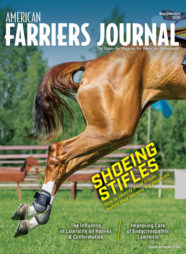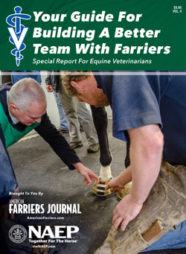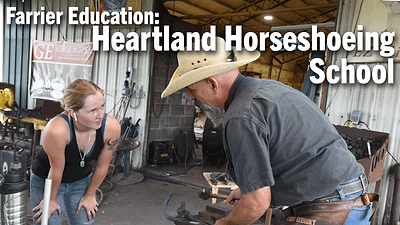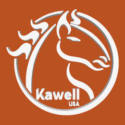One of the most valuable benefits of attending the 28th annual American Farrier’s Association (AFA) Conven?tion in early March in Lexington, Ky., was the tremendous amount of education that shoers received.
From new formulas for building shoeing business profits to the corrective shoeing of hock injuries, farriers were treated to a wide range of topics presented by some of the most respected hoof care experts in the world.
Requesting Radiographs
Farriers who come across severe lameness in horses need to know when it’s appropriate to request that X-rays be taken to help diagnose lameness causes. Michael Bowman, a Simpson?ville, Ky., equine veterinarian who specializes in lameness cases, outlined the necessary steps in conducting a lameness exam to help determine which bones or joints to X-ray.
“When a horse is lame enough to warrant taking X-rays,” he says, “the farrier and the vet need to work together to determine the best treatment plan to make the horse sound. What you learn at this stage will help you understand the physical damage to the lame horse’s bones or joints that has taken place.”
Tackling DIP Joint Concerns
Veterinary anatomy professor Jean-Marie Denoix of Maisons-Alfort, France, introduced a term, collateromotion, that he uses to describe passive movements in the frontal plane of the horse’s leg.
“Collateromotion of the digital joints,” Denoix says, “is a passive movement induced by asymmetric foot orientation. In the DIP joint, it’s accompanied by a narrowing of the joint space on the side of motion and opening on the opposite side, a sliding of P3 or P2 on the side of the elevated part of the foot and a rotation of P3 relative to P2 on the side opposite the elevation.”
Hock disorders, Denoix says, can be divided into two main classes:
1 “Lateromedial imbalance is most often seen in foals and is normally referred to in Europe as ‘cow hocks’,” Denoix says. “With this condition, the cannon bones deviate outwards and the fetlock joints are wider than the hocks.”
If the condition isn’t corrected during normal foal growth, corrective action may be necessary. In extreme cases, surgery is necessary.
Since there are variations in the way the bone develops, various shoeing methods are recommended based on specific deformations. For instance, if the fetlock joint has retained the correct orientation without inflammation, trimming the outer heel and quarters as well as fitting a shoe with a wide medial branch and narrow lateral branch will help support the internal side of the hocks. This will limit the internal strain on the ligaments and reduce external bone compression, Denoix says.
2 Lateromedial anomalies in adult horses basically includes osteoarthrosis which can cause a superficial deformation, generally medial, in bone spavin.
“Reducing bone compression on the medial side of the limb is indicated to reduce weight bearing of the foot on the internal ground surface and increase weight bearing on the external side,” says Denoix. “A shoe with a narrow internal branch and heel should be used and should not be fitted wide. With a wide web external branch and heel, the shoe should be fitted very wide. The toe should be square to facilitate rolling motion.”
While he recommends shoeing to provide good stability to the foot on the ground, he also suggests avoiding anything that limits rotation of the foot to avoid shearing stresses on digital and hock joints.
Modifications Spread Load
Foot landing patterns definitely have a significant effect on trimming and shoeing practices, David Hood, an equine veterinarian and director of The Hoof Project at Texas A&M University, told AFA convention attendees.
“Trimming the foot using a standard, non four-point technique,” Hood says, “results in a measurable increase in foot surface contacting the ground. While it seems confusing that removal of hoof wall, which makes the foot smaller, increases contact with the landing surface, this is what occurs.”
Hood maintains trimming brings more of the wall, bars, sole and frog in contact with the ground and disperses the load more evenly across the bottom of the foot. Trimming the areas of the wall which developed due to a lack of frictional wear are removed. Lowering the heels lengthens the foot’s solar surface. Together, these hoof modifications spread the landing load at impact and reduce pressure placed on any single part of the bottom of the foot.
Hood also pointed out to attendees how the effect of extended heels on load distribution differs between normal and lame horses.
“In non-lame horses with normal foot conformation,” Hood says, “preliminary data indicates egg bar shoes tend to increase the surface area in contact with the ground without moving the load toward the heels.
“However, the use of egg bar shoes in horses with chronic laminitis did shift a percentage of the load to the heels.”
Farrier’s Bottom Line
To operate a feasible business, a farrier must make a profit. Robert Hogan, a senior consultant for Moss Adams Advisory Services in Seattle, Wash., presented a number of formulas for farriers to use in determining ways to plan for more profit.
Using charts and a variety of profit-planning models, Hogan walked his audience through the steps necessary to manage a farrier business profitably.
With a top-down profit planning model, the farrier starts by estimating planned sales for the year. Next, the shoer works down a list of factors including variable and fixed costs, other income and interest expense to obtain a pretax profit.
With the bottom-up model, the farrier starts by choosing a pretax profit. Then the shoer works up the same list of factors to project the amount of sales required to meet that profit.
Hogan indicated that generating more sales can actually reduce profits. The reason, he maintains, is because increased sales can then lead to increased costs that more than offset the gain in revenue. The lesson to be learned for the farrier is: “More is not always better.”
Lower Limb Anatomy
Mitch Taylor, who operates the Kentucky Horseshoeing School in Mt. Eden, Ky., tackled equine lower limb mechanics with an organized approach.
“A knowledge of the detailed anatomy of the lower limb,” Taylor says, “is essential to properly understand lameness and other afflictions of the limbs.”
Taylor described characteristics and functions of various bone types, including long, flat and irregular bones. The cannon bone, splint bone, long pastern and short pastern are classified as long bones while the coffin, pedal, carpal and tarsal bones are classified as cuboidal.
The overall structural characteristics of joints include at least two bones, some cartilage, structural and non-structural ligaments and synovial fluid. The carpus or knee joint is made up of 11 bones and has very little medial-lateral movement, while the fetlock joint has four bones and is a major energy dissipation point.
Taylor says structural ligaments hold the skeleton together and help dissipate energy throughout the weight-bearing phases of a horse’s stride.
“The suspensory ligament is by far the largest and most stressed ligament of the lower leg,” Taylor says. “Other ligaments also serve to diminish the impact of landing on the feet as well as hold the bones together.”
On the other hand, the function of non-structural ligaments, Taylor says, is not to hold the skeleton together. These thinner, broader ligaments either encapsulate joints or help keep other tendons or ligaments in position during limb flexion or extension.
The two types of non-structural ligaments are capsular and annular ligaments. Capsular ligaments are those that encapsulate a joint and provide a sterile environment with no blood flowing through them. Inner membranes produce synovial fluid that lubricates the joint and provides essential nutrients normally delivered to living tissues by the horse’s blood.
Annular ligaments wrap around the bone and maintain the position of tendons and ligaments in and around the joints.
Super Learning
While these summaries are helpful, many farriers say they are no substitute for attending educational sessions in person. Farriers who go to the AFA convention say they walk away with much greater knowledge and understanding of their profession.
But it’s not only the lectures that impart knowledge. There’s also much to be gained by talking and networking with other shoers, hoof researchers and equine vets—many of whom find the learning that can be accomplished at this annual conference to be a highlight of their year.







Post a comment
Report Abusive Comment